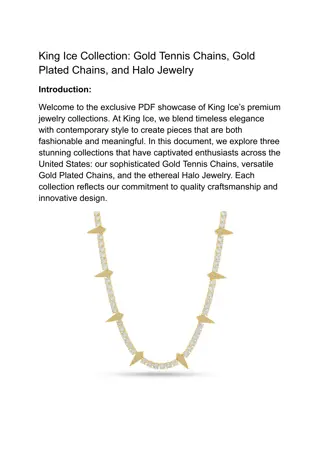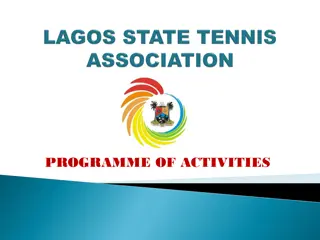2023 USTA Tennis Rule Changes & Competition Guidelines
Rule Change: Point Penalty System & Suspension of Point System. Unsportsmanlike conduct addressed for fair play. Follow USTA rules of competition for all matches. School team order of play guidelines also outlined.
Download Presentation

Please find below an Image/Link to download the presentation.
The content on the website is provided AS IS for your information and personal use only. It may not be sold, licensed, or shared on other websites without obtaining consent from the author. Download presentation by click this link. If you encounter any issues during the download, it is possible that the publisher has removed the file from their server.
E N D
Presentation Transcript
2023-24 NFHS/USTA TENNIS RULES POWERPOINT National Federation of State High School Associations USTA Rules of Competition USTA High School Committee
NATIONAL FEDERATION OF STATE HIGH SCHOOL ASSOCIATIONS (NFHS)
NATIONAL FEDERATION OF STATE HIGH SCHOOL ASSOCIATIONS NFHS (located in Indianapolis, IN Est. 1920): National leader and advocate for high school athletics and performing arts programs. Serves 51 state associations, 19,500 high schools and 12 million student participants. Writes playing rules for 17 high school sports for boys and girls. Offers online education courses for high school coaches, officials, parents, students and others. Ensures that students have opportunity to enjoy healthy participation, achievement and good sportsmanship in education-based athletics. www.nfhs.org
2023 USTA TENNIS RULES OF COMPETITION
Rule Change POINT PENALTY SYSTEM AND SUSPENSION OF POINT SYSTEM Unsportsmanlike conduct by player or person association with a player applies to unsportsmanlike conduct including abusive conduct by a person association with a player. Flagrant violations now allows a player to be defaulted immediately for the flagrant unsportsmanlike conduct of a person association with a player. Rationale: Expanded purpose of the system to include deterring unsportsmanlike conduct by persons association with players. www.nfhs.org
RULES OF COMPETITION United States Tennis Association (USTA) Amateur Tennis Rules, are the official rules for all tennis matches. Member associations of the NFHS independently make decisions regarding compliance with or modification of these playing rules for the student-athletes in their respective states. Coaches and players should know the rules governing tennis within their state as they are many times the adjudicators of those rules. To download a USTA Friend at Court rules book, see the link below: https://nfhs.org/media/6892935/2023-friend-at-court.pdf
ORDER OF PLAY Each school must enter its players in matches according to their established rank and position on the team. Matching up players or stacking is not permitted. In singles, players must compete in order of ability with the best player on the team playing at the No. 1 position, the second best at No. 2 and so on through all positions. In case of injury, sickness, or absence, all players must move up. This rule will apply to doubles play with the strongest doubles team at No. 1, etc.
SCORING AND MATCH FORMAT www.nfhs.org
AD SCORING Standard game - A standard game is scored as follows with the server s score being called first: No point - Love First point - 15 Second point - 30 Third point - 40 Fourth point - Game If each player/team has won three points, the score is Deuce . After Deuce , the score is Advantage for the player/team who wins the next point. If that same player/team also wins the next point, that player/team wins the Game ; if the opposing player/team wins the next point, the score is again Deuce . A player/team needs to win two consecutive points immediately after Deuce to win the Game .
NO AD SCORING SCORE IN A GAME (Rule 5): No-Ad SCORING METHOD A No-Ad game is scored as follows with the server s score being called first: No point - Love First point - 15 Second point - 30 Third point - 40 Fourth point - Game At three points all it s receiver s choice of side to return. USTA Comment V.1: When a Deciding No-Ad point is replayed, the receiver or receiving team may not change the choice of court to which the server must serve. www.nfhs.org
MATCH FORMAT There are three common formats used. 1. Best of three tiebreak sets 2. Best of three with Match Tiebreaker (10-point) in lieu of the third set 3. 8 game pro set/7-point Tiebreaker at 8-all
MATCH FORMAT Tie-break Set The first player/team to win six games wins that Set , provided there is a margin of two games over the opponent(s). If the score reaches six games all, a tie-break game shall be played. 10-Point Match Tiebreaker in lieu of deciding final set The first player/team to win 10 points by a margin of two over the opponent(s). Pro sets One set in which a player or team must win eight games by a margin of two games to win the match. If the score reaches 8-all, a 7-Point Tie break (first to 7 by a margin of 2) is played with the winner of the tiebreak winning the match. www.nfhs.org
TIE-BREAK GAME SCORING During a tie-break game, points are scored Zero , 1 , 2 , 3 , etc. The first player/team to win seven points wins the Game and Set , provided there is a margin of two points over the opponent(s). If necessary, the tie-break game shall continue until this margin is achieved. The player whose turn it is to serve shall serve the first point of the tie-break game. The following two points shall be served by the opponent(s) (in doubles, the player of the opposing team due to serve next). After this, each player/team shall serve alternately for two consecutive points until the end of the tie-break game (in doubles, the rotation of service within each team shall continue in the same order as during that set). CHANGE OF ENDS During a tie-break game, players shall change ends after every six points. www.nfhs.org
MATCH TIE-BREAK MATCH TIE-BREAK (10 POINTS) When the score in a match is one set all, one tie-break game shall be played to decide the match which is called a Match Tie-Break. This tie-break game replaces the deciding final set. The player/team who first wins 10 points shall win this match tie-break and the match provided there is a margin of two points over the opponent(s). Note: When using the match tie-break to replace the final set: the original order of service continues. (Rules 5 and 14) in doubles, the order of serving and receiving within the team may be altered, as in the beginning of each set. (Rules 14 and 15) before the start of the match tie-break there shall be a 120 seconds set break. balls should not be changed before the start of the match tie-break even if a ball change is due. www.nfhs.org
PRO SET Unless otherwise specified, a pro set is one set in which a player or team must win eight games by a margin of two games to win the match. If the score reaches 8-all, a 7-Point Tiebreak (first to 7 by a margin of 2) is played, with the winner of the tiebreak winning the match by a score of 9-8(x), where x is the number of point won by the player or team who lost. www.nfhs.org
DISPUTES OVER THE SCORE Disputes over the score shall be resolved by using one of the following methods, which are listed in the order of preference: Count all points and games agreed upon by the players and replay only disputed points or games; If the players do not agree on the court in which the disputed point started, toss a coin to select the court; If the players do not agree on who served a disputed point in a tiebreak, toss a coin to select the server (A coin toss may also be needed to determine the side in which the point is played and the end from which the server serves.); If the players do not agree on who served a disputed game, toss a coin to select the server; Play from a score mutually agreeable to all players; www.nfhs.org
CONTINUOUS PLAY www.nfhs.org
CONTINUOUS PLAY As a principle, play should be continuous, from the time the match starts (when the first service of the match is put in play) until the match finishes. The receiver must play to the reasonable pace of the server. When the players change ends at the end of a game, a maximum of ninety (90) seconds are allowed. However, after the first game of each set and during a tie-break game, play shall be continuous, and the players shall change ends without a rest. www.nfhs.org
CONTINUOUS PLAY USTA Comment 29.1: The 25-second time limit does not apply if a player has to chase a stray ball. At the end of each set there shall be a set break of a maximum of one hundred and twenty (120) seconds. The maximum time starts from the moment that one point finishes until the first service is struck for the next point. www.nfhs.org
CONTINUOUS PLAY A limited amount of toilet/change of attire breaks may also be allowed, if this is announced in advance of the event. Preferred at end of set. Event organizers may allow a rest period of a maximum of 10 minutes if this is announced in advance of the event. This rest period can be taken after the 2nd set in a best of 3 sets match. The warm-up time shall be a maximum of five minutes, unless otherwise decided by the event organizers. www.nfhs.org
CONTINUOUS PLAY USTA Comment 29.2: When are the players entitled to another warm-up after their match has been suspended? (i.e., weather delay) The players are entitled to a re-warm-up of the same duration as the original warm-up if a match has been suspended for more than 15 minutes. They are not entitled to a re-warm-up after a rest period. www.nfhs.org
MEDICAL TIME-OUTS www.nfhs.org
MEDICAL TIME-OUTS, BLEEDING TIME-OUTS When Time-out May Be Taken Medical condition during warm-up Immediately after request At the end of warm-up Medical condition during a match (3-minute time-out after diagnosis) Immediately after request Next changeover After qualified medical person or trainer evaluates and is prepared to treat the medical condition After referee or other official arrives and explains the medical time-out provision Visible bleeding Mandatory bleeding time-out begins when player notifies official or acknowledges that there is visible bleeding No extra time shall be given to allow a player to recover condition. If a certified athletic trainer is available to evaluate and diagnose an injured athlete, the medical time-out (three minutes) does not begin until the diagnosis is made, and treatment begins. www.nfhs.org
COACHING www.nfhs.org
COACHING ON CHANGEOVERS Coaching & Advice During Competition Coaching restrictions may be established by each state association. Communication must not delay or interfere with continuous play. Coaching by other players, parents or spectators during play and between games or sets during a match is prohibited. www.nfhs.org
COACHING WITH PHONES/ ELECTRONIC DEVICES USTA Comment 30.1: A player may bring to the court written notes that were prepared before the start of the match and may read these notes during the match. While on court or during a match, a player may not receive information via electronic devices capable of receiving communications such as cell phones and smartwatches. State associations may restrict the wearing of smartwatches. www.nfhs.org
CLAIMING A HINDERANCE www.nfhs.org
CLAIMING A HINDERANCE Claiming a hindrance A player who claims a hindrance must stop play immediately. Talking when ball is in play. Singles players should not talk during points Talking between doubles partners when the ball is moving toward them is allowed. Doubles players should not talk when the ball is moving toward their opponent s court. Any talking that interferes with an opponent s ability to play a ball is a hindrance. www.nfhs.org
CLAIMING A HINDERANCE Claiming a hindrance For example, if a player yells after an injury or getting stung by a bee, this is an unintentional hindrance that would entitle the opponent to claim a let. Body movement: A player may move to improve position while a ball is in play. A player may change position at any time, including while the server is tossing a ball. Any other movement or any sound that is made solely to distract an opponent, including, but not limited to, waving arms or racket or stamping feet, is not allowed. www.nfhs.org
CLAIMING A HINDERANCE Let due to unintentional hindrance and loss of point due to deliberate hindrance: A player who is hindered by an opponent s unintentional act or by something else outside the player s control is entitled to a let only if the player could have made the shot had the player not been hindered. A let is never authorized for a hindrance caused by something within a player s control, such as when a player s racket comes out of a hand, when a player s shoe comes off, or when a player trips over the player s own hat. However, if a player s hat falls off during a point, an opponent may immediately call a let due to unintentional hindrance. www.nfhs.org
CLAIMING A HINDERANCE Out calls and other noises from spectators are not hindrances and, therefore, are not considered grounds for a player calling a let or claiming the point. A ringing cell phone is a deliberate hindrance; if an opponent s cell phone rings during a point, the player may immediately stop and claim the point. Another example of a deliberate hindrance occurs when the receiver asks the server to stop discarding the second ball after serving, and the server continues to discard the second ball. Continued discarding of the ball constitutes a deliberate hindrance, entitling the receiver to immediately stop play and claim the point. www.nfhs.org
CLAIMING A HINDERANCE Grunting: A player should avoid grunting and making other loud noises that could distract the opponent(s). Grunting and other loud noises may bother not only opponents but also players on adjacent courts. In an extreme case, an opponent or a player on an adjacent court may seek the assistance of an official. Grunting and the making of loud noises that affect the outcome of a point are hindrances. Only an official may rule that these actions are hindrances and order that a let be played or a loss of point, depending on whether an official had previously warned the offending player. www.nfhs.org
CLAIMING A HINDERANCE Injury caused by player: When a player accidentally injures an opponent, the opponent suffers the consequences. Consider the situation where the server s racket accidentally strikes the receiver and incapacitates the receiver. The receiver is unable to resume play within the time limit. Even though the server caused the injury, the server wins the match by retirement. On the other hand, when a player deliberately injures an opponent and affects the opponent s ability to play, then the opponent wins the match by default. Hitting a ball or throwing a racket in anger is considered a deliberate act. www.nfhs.org
SPORTSMANSHIP/CODE OF CONDUCT www.nfhs.org
SPORTSMANSHIP AND ETIQUETTE Player shall not engage in unsportsmanlike conduct. A player shall not at any time (on or off court) engage in: Verbal abuse: Swear at an official, a spectator, or an opponent in a voice that can be heard by any person; Visible or audible profanity or obscenity: Use profanity or insulting, abusive, or obscene language in any way that may be heard by any person or use obscene, insulting, or abusive gestures; Racket abuse: Throw or break a racket other than in the normal course of play; Ball abuse: Deliberately hitting, throwing, or kicking a ball that is not in play if the ball: leaving the playing area; hits or comes close to hitting any person; or could cause damage or harm. Physical abuse: Threaten or inflict bodily injury to anyone; or Other unsportsmanlike conduct
CODE OF CONDUCT Carry-over of code violations occurring after a match is over to player s next match during individual competition: If a player commits a code violation after his singles match is over, the penalty shall be assessed: (1) at the start of his next singles match; but (2) if he has been eliminated from all singles competitions, then the penalty will be assessed at the start of his next doubles match. If a player commits a code violation after his doubles match is over, the penalty shall be assessed: (1) at the start of his next doubles match; but (2) if he has been eliminated from all doubles competitions, then the penalty will be assessed at the start of his next singles match. www.nfhs.org
RECOVERY RULE State association may have differing guidelines for both time between matches and matches per day.
USTA High School Resources Resources
USTA Grants & Assistance The USTA offers a variety of grants to help grow the game of tennis. Get support and find out how the USTA and USTA Foundation can help with grants, equipment discounts, and more. Visit https://www.usta.com/en/home/coach- organize/tennis-support/grants-assistance.html for more information. Grants & Assistance
Team Tennis Manual Nearly 100 pages consisting of 29 turnkey practice plans covering preseason conditioning, in season plans to postseason play. Made for you with you in mind piloted by over 40 coaches. All activities optimized for No-Cut Coaches and can be done by up to 12 players per court with no coach feeding. Accessible in the USTA Curriculum Center and Net Generation Mobile App. All activities/drills have supporting videos viewable on App Download a PDF version here. Team Tennis Manual
How do I get the Manual Register your team on www.USTA.com Visit: https://www.nfhs.org/media/4860270/school-team-registration- 8520-3.pdf for instructions on how to register your team. If you would like to receive a hard copy of the Team Tennis Manual or have questions, please reach out to NetGenerationSchools@usta.com Team Tennis Manual
Officiating is Calling Join our Team!
We are USTA Officials. THE ULTIMATE TENNIS EXPERIENCE BEGINS WITH US. We don t just make calls. We make our sport fun and fair. We don t just oversee the game. We are ambassadors for the sport. We teach, learn, listen and lead. Our diversity gives us strength. Our mission unities us all.
OVER 17.8 MILLION COURSES DELIVERED! Concussion in Sports 7M Heat Illness Prevention 2.1M+ Sudden Cardiac Arrest 2.2M+ The Collapsed Athlete (2020) 51,000+ Concussion for Students 1.1M+ Implicit Bias (2021) 90,000+ Fundamentals of Coaching 900,000+ First Aid, Health and Safety 400,000+ Protecting Students from Abuse 220,000+ Student Mental Health and Suicide Prevention 227,000+ Bullying, Hazing and Inappropriate Behaviors 400,000+ Appearance & Performance Enhancing Drugs and Substances 118,000+ COVID-19 for Coaches and Administrators 360,000+ www.nfhs.org
NFHS NETWORK By 2025, every high school sporting event in America will be streamed live. The NFHS Network will be THE DESTINATION for fans to view these broadcasts. 27 Different Sports and Activities www.NFHSnetwork.com























